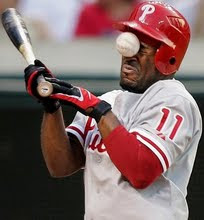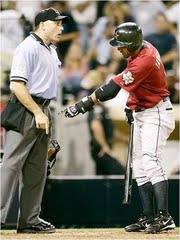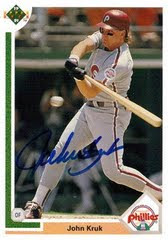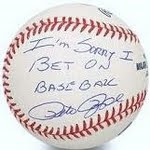Duly noting that "Greinke the Yankee" would have been an infinitely better title, a question lingers as the dust from the most recent "blockbuster" trade settles: how valuable is Zack Greinke now that he is in the NL (Central)? That is the topic of today's conversation.
Before we look at Greinke's prospective 2011, let's look at his past and his pre-trade expectations.
Drafted with the sixth overall pick in 2002, Zack Greinke has been many things in his brief major league career. He was a stud prospect who played in the Futures Game (then again, so did Neil Cotts...) and was touted highly by Baseball America. Rushed to the majors, he pitched relatively well in 2004, logging a 3.97 ERA (4.28 xFIP), a 1.17 WHIP, and 6.21 strikeouts per nine innings over 145 innings as a rookie.
Greinke was also a "bust" in 2005, pitching 183 innings of 5.80 ERA, 4.64 xFIP, 5.61 K/9 baseball. The young hurler then walked away from baseball in 2006 with depression and anxiety issues, only to return in a primarily-relief role in 2007. He was successful on the surface (3.69 ERA), but his 45.5% flyball percentage overall and 4.28 xFIP indicated that he may have been pitching a bit over his head. As a starter in 2007, Greinke logged a 3.80 ERA, but his 6.68 K/9 and 4.69 xFIP were well below the quality of his numbers as a reliable reliever (9.28 K/9, 3.77 xFIP). At this point in his career he barely whelmed Royals fans.
Then, in 2008, Greinke took his first big step forward. As a full-time starter, he struck out 183 batters (8.14 K/9) and walked a mere 56 hitters (2.49 BB/9) over the course of 202.1 strong innings for the Royals (3.47 ERA, 1.28 WHIP). His peripherals were also strong, as he logged a career-best 3.76 xFIP and 3.77 tERA with a much stronger groundball showing (42.7%) than he had ever posted prior. His 3.47 ERA that season was the lowest ERA logged by a full-time Royals starter in 11 years and Dayton "trust the process" Moore rewarded Greinke with a ridiculously team-friendly, four-year, $38 million contract that bought out the rest of Greinke's arbitration years plus two free agency years.
2009, however, was Greinke's breakout season. Fantasy owners who took a shining to him and put stock in his 2008 showing were greatly rewarded with fantasy and surface statistics which, like Tim Lincecum, matched his underlying peripherals. By season end, Greinke "only" accumulated 16 wins (because the Royals offense was truly terrible that season), but he tossed 229.1 strong innings of 2.16 ERA, 1.07 WHIP baseball with 242 strikeouts to a meager 51 walks (4.75 K/BB, second to only Roy Halladay's 5.94 mark in the AL).
His peripherals were just as solid as his fantasy numbers: 9.50 K/9, career best 9.9 Swinging-Strike Percentage (SwStr%), 2.00 BB/9, 0.99 GB/FB ratio, 3.15 xFIP, 2.33 FIP, 2.59 tERA. Baseball Monster ranked Greinke as the second-most-valuable fantasy player of 2009 for rotisserie leagues, behind only Albert Pujols. In terms of value per outing, he ranked fourth (per Baseball Monster), behind only Albert Pujols, Tim Lincecum, and Chris Carpenter.
Given Greinke's 2009, 2010 was a slight disappointment. His career-best groundball showing (46.0%) was offset by a huge step back in the strikeouts column (7.40 K/9, 7.5% SwStr%) and a little regression with the free passes (2.25 BB/9). While still a strong pitcher (his numbers were on par with the peripherals of Ricky Romero, Ubaldo Jimenez, Clayton Kershaw and C.C. Sabathia), the Royal's truly terrible combination of awful defense (-45.5 team fielding runs) and no hitting ability (-8.2 team batting runs) led to lackluster numbers on Greinke's end: 4.17 ERA and 10 wins to 14 losses. But hey, his 1.25 WHIP was still solid.
Heading into 2011, Greinke had been the center of a lot of trade rumors this offseason and with good reason, too. He was clearly the best available pitcher on the market, and if CC Sabathia does not opt out of his contract with the Yankees following the 2011 season, the best free-agent pitcher on the market next off-season will likely be a battle of Number Twos between Ryan Dempster (who will be 35 years old), Hiroki Kuroda (37 years old), Javier Vazquez (35 years old) and Wandy Rodriguez (33 years old) if the Astros do not extend him.
Greinke, only 27 right now, is affordable (two-years, $27 million), imposes minimum health risk (no history of physical injury, only a two-year commitment), and will likely end up with Type-A status and therefore net his employer some prospects in 2013 if deemed too expensive to extend long term. Victor Wang's free agent compensation valuation research and some number manipulation courtesy of Sky Kaulkman reveals that "the average Type-A compensation package averages around $5.5M in value." Accordingly, Greinke's expected "cost" (ignoring the offset of prospects traded for him) is only $21.5 million over the next two seasons.
Using a $5 million rate per win commensurate with this offseason's spending by teams, he would only need to be worth a cumulative +4.3 WAR over the next two seasons, or about +2.2 WAR per season, to be worth his salary. Greinke has been worth at least that per Fangraphs' WAR valuation (FIP-focused) every year that he has pitched in the major leagues except 2006, where he logged a mere 6.1 innings.
Noting this, you can understand why, in real life, a team like the Brewers would want to acquire Greinke, especially with Prince Fielder most likely leaving and the other established major league talent on the roster (Rickie Weeks, Corey Hart, etc.) getting more expensive and ever closer to free agency. This trade by the Brewers, along with the Shaun Marcum deal, is a clear win-now-and-next-year move. But I digress.
Prior to the trade, Greinke was positioned at No. 22 in my top 100 starting pitcher rankings (to be released in January). The perpetually poor defensive posture of the Royals, the failure of Dayton Moore to convincingly upgrade the offense, and the recent influx of hitting talent to the AL Central (Victor Martinez, Adam Dunn, Tsuyoshi Nishioka) kept me from green lighting dollar allocation commensurate with another 2009 or relatively elite season, irrespective of Greinke's pitching abilities. On the Royals, he was pegged for a 3.90 ERA, 1.25 WHIP and an 8.0ish K/9. Strong numbers, but Ubaldo Jimenez, Mat Latos, Chad Billingsley or even Shaun Marcum may be safer choices.
The move to the NL (and the NL central, no less) changes everything, however, and a reassessment is necessary. This background set, let's move to the post-trade analysis.
Before forecasting Greinke's 2011, it is necessary to settle upon a baseline set of numbers to massage into a rough projection. Let's start with the strikeout rate. Since returning to his role as a full-time starter in 2008, Greinke has posted Swinging-Strike rates of 9.3%, 9.9%, and 7.5%. The major league average is around 8.5%. Greinke's K% (the major league average is 17.2%) and K/9 over this period closely track the changes in SwStr%: 21.5% (8.14 K/9), 26.4% (9.50 K/9), 19.7% (7.40 K/9).
What caused Greinke's change in whiffs is difficult to pin down. Perhaps it was a matter of pitch selection and pitch quality. A quick glance at the pitch values and usages on Fangraphs indicates that Greinke was utilizing a slightly-above-average curveball 12% of the time in 2009 and 14.3% in 2009. In 2010, the curveball was a below average pitch, which he only utilized 10% of the time.
Greinke also turned to his best pitch, the slider, less often in 2010. Whereas he went to a slider (worth more than +2.3 runs per 100 times thrown in each of 2008, 2009, and 2010) 18.8% of the time in 2008 and 20.2% of the time in 2009, Greinke's usage percentage dropped to 15.5% in 2010.
This decreased usage of sliders and curveballs manifested in the form of increased changeup usage, who tossed the pitch 13.0% of the time last year after throwing it only 7.7% of the time in 2008 and 6.1% of the time in 2009. The changeup is by far and away Greinke's worst pitch in his four-pitch arsenel. At a pitch value of -0.87 runs per 100 times thrown over the course his career, the changeup is Greinke's only distinctively below-average pitch.
While pitch classification is an inexact science, these usage changes of greater than five percent seem to indicate something. What, if anything, is difficult to say, especially if the numbers are just changes in the classification algorithms. I will defer to others, who are warmly welcomed to constructively explain/criticize the data in the comments, to make the qualitative judgments. The primary concern here is to identify possible explanations for Greinke's strikeout fluctuations.
Greinke's strikeout stuff, be it by luck or modifications in pitch selection or something else, should rebound somewhat in 2011. As noted above, in the AL his expected K/9 was around 8%. Using Greinke's 2008 (21.5% K%) as a rebounding point, let's move on to projecting an innings total and an expected batters-faced figure.
Greinke has logged 200+ innings each of the past three seasons as the Royals' ace. Assuming he is anointed the Brewers' ace and routinely gets the standard four days of rest treatment (a lofty assumption in light of the Brewers' desperate usage of C.C. Sabathia in 2008), a 162-game schedule would give Greinke 33 prospective starting opportunities. Given that he has started 98 games over the past three seasons, 33 games started seems like a fair starting projection.
Over the past three seasons, Greinke has average 6.2 innings per outing. Keeping this figure constant and applying it to his 33 expected games started, we get an expected innings total baseline of 220. As noted last month in my Ted Lilly analysis, "an average of 4.31 batters have come to the plate per inning" over the past three seasons. Applying this rate to our 220 innings baseline for Greinke, we get an expected total batters faced (xTBF) figure of approximately 948.
Taking Greinke's xTBF of 948 and applying his 2008 strikeout rate (21.5%), we find that his expected strikeout total for 2011 would have been 204, for a K/9 of 8.35, had he remained with the Royals. Greinke was traded to the Brewers, however, and facing a pitcher every ninth batter rather than a DH clearly has an impact on a pitcher's strikeout rate.
According to Derek Carty's research from two years ago, pitchers switching from the AL to the NL tend to see a +0.57 increase in their K/9. Applying that figure to Greinke's expected mark had he stuck with the Royals (8.35), we find a new expected K/9 of approximately 8.92. This would raise Greinke's strikeout total from 204 to 218 over the course of 220 innings pitched.
Next, we need an ERA baseline to manipulate. Greinke's golden 2009 was book-ended by two seasons of 3.76 xFIPS, with tERAs of 3.77 and 3.51 in 2008 and 2010, respectively. Given Greinke's career ERA of 3.82, let's semi-arbitrarily settle upon a 3.65 ERA as the baseline for this analysis. That accounts for the likelihood of his "true talent" being around 3.76 with a realization that 3.76 might be a bit of an undersell. Over the course of 220 innings pitched, a 3.65 ERA would approximate into 89.2 total runs allowed (RA).
First accounting for a change in league per Derek Carty's league changing research for pitchers, an AL-to-NL switch for pitchers tends to subtract 0.42 runs per nine off a pitcher's bottom line ERA. Over the course of 220 innings, that 0.42 runs per nine translates into approximately 10.3 fewer runs allowed. Subtracting this figure off of Greinke's baseline RA total, we find a new NL-adjusted expected RA total of 78.9.
Next, we need to adjust for park figures. According to Baseball-Reference.com's multi-year park factor data, Miller Park surprisingly depresses offense by about 4 percent. Multiplying Greinke's NL-adjusted expected RA figure by 0.98 (as the Brewers only play half of their games at home), we get a new league-and-park-adjusted RA total of 77.3. That figure would approximate into an ERA of 3.16.
The next step in the expected ERA analysis is quite tricky. As noted in my Ted Lilly analysis:
Figuring out the defensive adjustment for the Dodgers in 2011 is a less exact process than the park factor adjustment. Mathematically speaking, you take the team's cumulative UZR and divide it by the team's total innings played in the field and then multiply by the individual pitcher's expected innings total. You then subtract this number (which will either be negative or positive, depending on the quality of the team defense) from the pitcher's adjusted runs allowed. Simple, right?
Not exactly. This formulation of defensive adjustment makes several assumptions which are not true. Dave Cameron recently explained in detail the problems of measuring defense as it applies to a pitcher's value in a two-part post on Fangraphs. There are two primary problems:
First, not all pitchers will get equal defense. Defense measures a total of groundball, line drive and flyball fielding ability. Not all players have an equal distribution of fielding talent between all types of fielding scenarios. A groundball pitcher will probably not get the same level of defense as a flyball pitcher.
Second, this defensive adjustment approach assumes that a team's cumulative UZR in a season reflects that team's true defensive ability. This is incorrect for three reasons: roster turnover, the unpredictable distribution of fielder playing time (especially in the NL, where player substitutions define the predominant late-game strategy), and the unreliability of single-season fielding data.
As should be obvious by the above quote, applying defensive adjustments to pitchers is highly inaccurate. Given this and the Brewer's largely average defense last season (-4.7 team fielding runs) and returning cast of characters, minus Jim Edmonds and his +7.0 UZR glove in 2010, let's leave Greinke's league-and-park-adjusted RA total of 77.3 largely untouched. Feel free to apply a defensive adjustment as you see appropriate, but for the purposes of this analysis, we are merely going to round out Greinke's expected ERA to 3.20.
With a strikeout rate/total and expected ERA in place, we turn finally to Greinke's prospective WHIP and walk rate. His walk rate over the past three seasons has remained largely stable. His F-Strike% has fluctuated between 61.6% and 62.4%, while walking 56 batters in 2008, 51 batters in 2009 and 55 batters in 2010. Greinke also plunked 15 batters to only two intentional free passes (+13 net modified walks (mBB*)).
*mBB = BB - IBB + HBP
If we smooth out Greinke's three-year control rates and account for the +13 modified walks over three seasons, Greinke's expected BB% comes out to 6.5%. Applying this to Greinke's 948 xTBF figure, we get an expected modified walk rate total—ignoring the change in leagues—of 61.8. Alternatively, Greinke's expected BB/9 is 2.53. Derek Carty's league change research for pitchers indicates that pitchers moving from the AL to the NL largely see their walk rates remain constant, only decreasing by 0.05 walks per nine. Applying this figure, we find a trade-adjusted modified walk total for Greinke of 63.
With an expected mBB in place, we turn finally and optimistically to Greinke's 2010 batted ball distribution to find an expected WHIP using the beta formula for version 2.0 of my xWHIP Calculator (not yet on "public release," but it will be shortly after the new year—until then, you can download xWHIP version 1.4.3 by clicking here).
Last season, Greinke allowed 659 balls in play (BIP) and his batted ball distribution was 117 line drives (17.8 LD%), 303 ground balls (46.0% GB%), and 239 fly balls (36.3% FB%), with 21 infield flies (8.8%). Carty's league change research indicates an AL-to-NL league change for pitchers tends to result in a +0.37% LD% and a +0.33% GB% at the expense of a -0.70% change in FB%. Likewise, there is an expected +0.11% IFFB% at the expense of a -0.11% change in OFFB%. Applying these numbers, we find a new distribution of 119.4 LD, 305.2 GB, 234.4 FB, 20.9 IFFB, and 213.5 OFFB, keeping the BIP total constant.
Plugging these numbers, plus Greinke's expected mBB rate of 63, into the beta version of the xWHIP 2.0 calculator...

...we find an expected WHIP of 1.235. Modify the figure as you see fit based upon the Brewers' prospective defense. The expected innings figure (228) is a new feature of the xWHIP 2.0 calculator, and while it reveals a previous year's (or set of years') defense-independent expected innings total, expected innings is really only relevant in this context for the purpose of determining an expected WHIP. Version 1.4.3 of my xWHIP calculator, which utilizes actual innings (220 here) and is generally pessimistic on individual pitchers, spits out an expected 1.286 WHIP -- still a strong figure. Essentially, a WHIP repeat of last season for Greinke is entirely plausible.
All the above considered, Greinke's expected pitching line for 2011 is something along the lines of: 220 IP, 3.20 ERA, 218 K, 63 mBB, 3.46 K/BB, and a 1.235 WHIP. Oliver is slightly more pessimistic overall, projecting Greinke the Brewer for a 3.49 ERA, 1.21 WHIP, 200 K and 55 BB over 218 innings pitched in 2011. Bill James is even more pessimistic, forecasting a 3.57 ERA, 1.24 WHIP, and 193 K to 56 BB over 222 IP. Both Oliver and Bill James forecast 13 wins, but I'm willing to go closer to 16 provided the Brewers do not disassemble their team come July.
No matter whether you believe my projections, Oliver's or Bill James', Greinke's prospective 2011 numbers seem solid. Given his WHIP upside, the trade to the Brewers bumps him up from No. 22 on my starting pitchers list to No. 13, ahead of Jered Weaver, Max Scherzer, and Cole Hamels, but behind Francisco Liriano.
Greinke has gone from an overrated fantasy asset to a potentially break-even investment, which is what you look for in your high-bid, early-round studs. Others are likely to take note of Greinke's propensity for greater things in 2011, but if you can get him outside the top 50 names picked off the board, you might be in a good position, like the Brewers, with your ace.







3 comments:
Jesus Christ dude, know your audience. This post in unnecessarily long. All people care about is what Grienke's numbers will be in 2011.
1) I know people like reasoning rather than blind faith
2) The bottom line is bolded at the bottom for anyone who just wants the numbers
Zack Grienke was a Brewer and a Patriot
Great work as always, but WWWWWAAAAYYYY too freaking long
Post a Comment